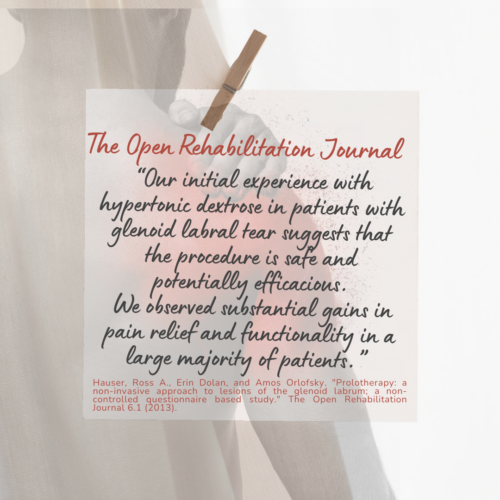
Glenoid Labrum Repair with Prolotherapy
The shoulder is quite an amazing and incredibly mobile joint. However, an injury to the glenoid labrum of the shoulder can keep you from reaching your sports or professional goals. If you are a tradesman or woman whose work requires repetitive overhead motion to accomplish your trade, and shoulder pain makes your day almost impossible, a labral injury may be part of the problem.
Athletes and others who rely on their shoulders for the movements necessary to carry out their sports and professions are especially susceptible to injuries and tears of the glenoid labrum. There are a couple of types of labral tears. A SLAP tear (Superior Labral, Anterior to Posterior) is one of the most common and results in a tear from the front to the back of the glenoid labrum. Other labral tears include flap tears, Bankart lesions, and degenerative lesions.
With the injury to the glenoid labrum of the shoulder, overhead strokes of a painter can be difficult, too. Or the strum of a chord for a guitar player may bring shooting pains. A pitcher might experience pain while throwing a ball, compromising big hopes for the season. Shoulder pain from a glenoid labrum injury can put a significant damper on your life. And those suffering from the injury want a quick way out of discomfort to get their lives back. Getting there non-surgically would be an added bonus.
The shoulder has a lot of mobility. The shoulder lacks significant ligamentous structures to add to its ability to move well. But that also makes it more prone to injury since big ligament structures would add support. The glenoid labrum provides some stabilization for the shoulder. So, it is a vital shoulder structure.
The glenoid labrum is a smooth ring of fibrous cartilage surrounding the shoulder’s ball and socket joint. The shoulder joint has three bones that come together: the scapula (shoulder blade), the clavicle (collar bone), and the humerus (upper arm bone). The glenoid labrum is located where the top part of the upper arm comes into contact with the socket in the scapula. It forms a deep pocket that helps keep the humerus bone in the shoulder socket and provides a pain-free range of motion.
The labrum has multiple functions that contribute to stabilizing the glenohumeral joint. The joint’s bony structure is designed to optimize range of motion at the expense of stability, as the humeral head is four times larger than the glenoid cavity.
As noted above, the ball at the top of the arm is larger than the socket. Therefore, the labrum helps to stabilize the shoulder by increasing the socket depth and providing a place for the ligaments and tendons to attach. When injured, the labrum is unable to do its job adequately. And pain and symptoms are experienced.
Injuries to the labrum occur during traumatic events, with repetitive motions, or from recurrent dislocations. Other soft tissue, such as the ligaments and tendons, are often injured along with the damaged labrum. This is because forces strong enough to injure the labrum will also be sufficiently forceful to injure them too.
Keep this in mind when seeking repair. Because all of the injured shoulder structures need to be treated in order to achieve complete healing of the shoulder joint. Otherwise, a cycle of shoulder injury, re-injury, and pain will be set in motion.
When the glenoid labrum is torn or injured, the shoulder may feel unstable, go out easily, and be susceptible to dislocations. The shoulder may also click, catch, and lock because the torn parts get “trapped” when the shoulder joint moves. Pain is usually noticed with overhead activities, along with the popping, locking, catching, or grinding sensations during movement. Weakness, instability, and loss of range of motion may also be experienced.
Glenoid Labrum Injuries Treated with Regenerative Orthopedics
Regenerative Orthopedics effectively treats and repairs glenoid labrum injuries without the need for surgery. Athletes might look to surgery in an attempt to return quickly to their sport. But is a quick return the actual outcome of surgical repair? It might not be!
Researchers in the medical journal “Arthroscopy” say, “SLAP repair in throwing athletes should be approached with caution. Surgery may help improve symptoms but may not guarantee a return to the pre-injury level of competition. And even in the most expert of hands, the rate of return to the pre-injury level of performance ranges from 38% to 60% and is as low as 10% for pitchers.”(1)
Non-Surgical Regenerative Orthopedics repairs the shoulder joint’s underlying instability by treating all of the damaged soft tissue structures. Without this repair, the labral tear, ligament injury, or tendon damage will cause the shoulder to remain unstable. And shoulder problems, immobility, and impingement will continue.
Our initial experience with hypertonic dextrose in patients with glenoid labral tear suggests that the procedure is safe and potentially efficacious. We observed substantial gains in pain relief and functionality in a large majority of patients.
Regenerative Orthopedics has several advantages. It is non-surgical, which avoids the risks of anesthesia and the cutting, scraping, and probing that can contribute to joint instability.
Other advantages include minimal time missed from work and no long recovery times. Regenerative Orthopedics stimulates the repair of the shoulder’s labrum and other soft tissue structures, significantly improving pain levels, alleviating stiffness and the need for pain medication, and returning motion to the shoulder joint. The repair allows for an accelerated return to sport and the profession you enjoy.
1 Makhni EC. Editorial Commentary: Buyer Beware—Throwers Undergoing Type VIII SLAP Repair Should Do So With Very Reasonable Expectations.
2 Hauser RA, Dolan E, Orlofsky A. Prolotherapy: A Non-Invasive Approach to Lesions of the Glenoid Labrum; A Non-Controlled Questionnaire Based Study. The Open Rehabilitation Journal. 2013 Dec 27;6(1).